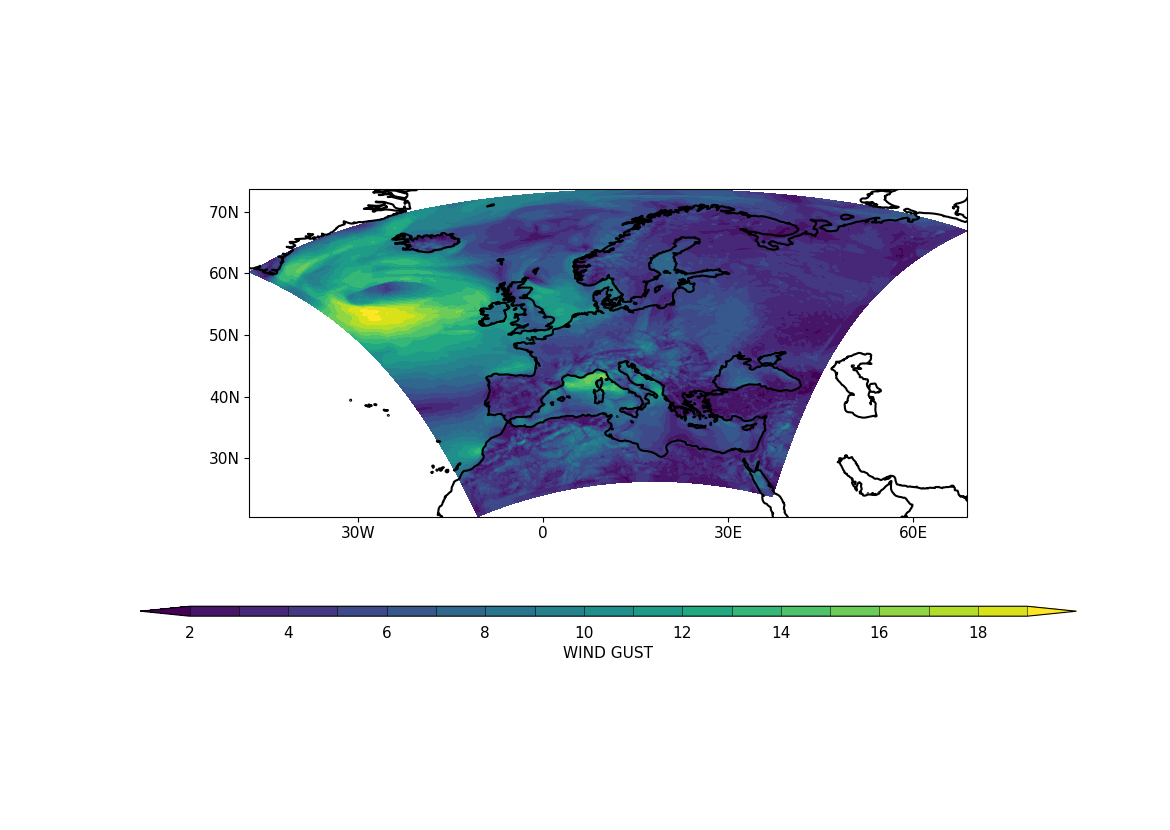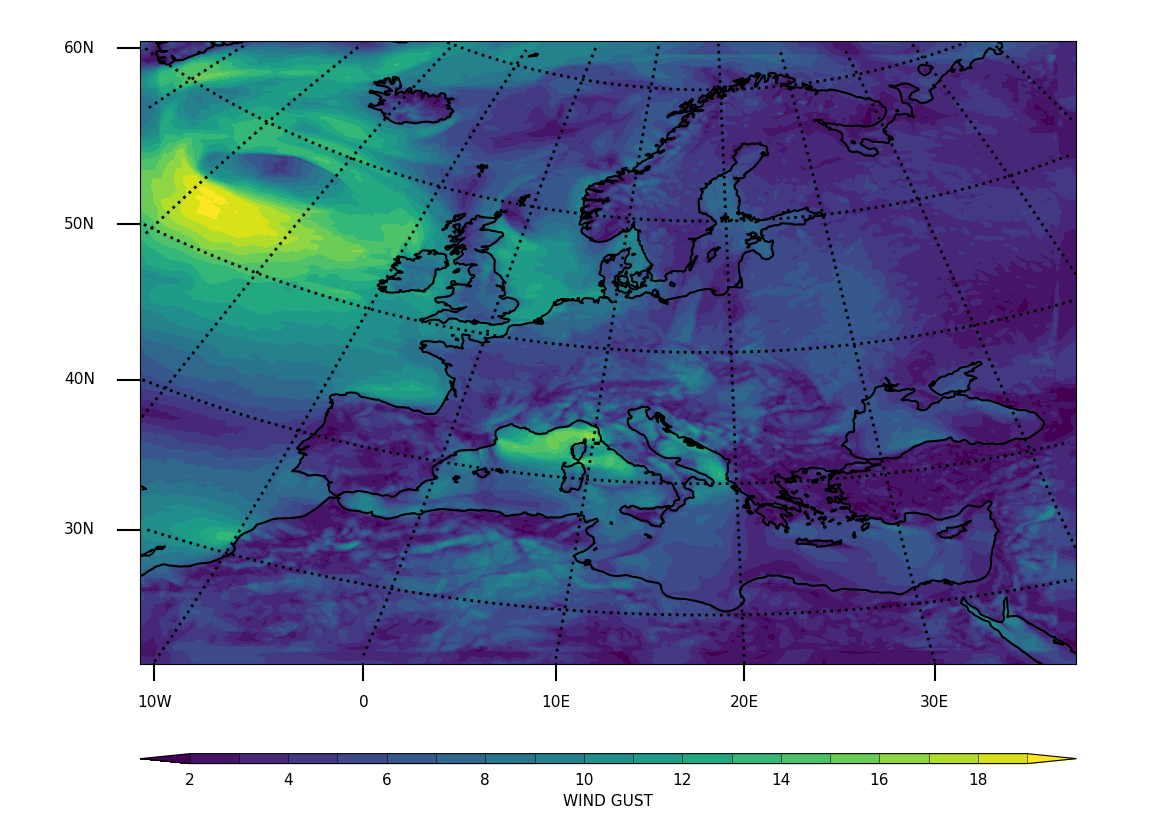Note
Click here to download the full example code
Converting from rotated latitude-longitude to regular latitude-longitude¶
In this recipe, we will be regridding from a rotated latitude-longitude source domain to a regular latitude-longitude destination domain.
Import cf-python, cf-plot and numpy:
import cfplot as cfp
import cf
Read the field constructs using read function:
[<CF Field: id%UM_m01s03i463_vn1006(time(8), grid_latitude(432), grid_longitude(444))>]
Select the field by index and print its description to show properties of all constructs:
-----------------------------------------------------------
Field: id%UM_m01s03i463_vn1006 (ncvar%UM_m01s03i463_vn1006)
-----------------------------------------------------------
Conventions = 'CF-1.10'
_FillValue = -1073741824.0
history = 'Converted from UM/PP by cf-python v3.15.2'
lbproc = '8192'
lbtim = '122'
long_name = 'WIND GUST'
runid = 'aaaaa'
source = 'UM vn1006'
stash_code = '3463'
submodel = '1'
um_stash_source = 'm01s03i463'
Data(time(8), grid_latitude(432), grid_longitude(444)) = [[[5.587890625, ..., 5.1376953125]]]
Cell Method: time(8): maximum
Domain Axis: grid_latitude(432)
Domain Axis: grid_longitude(444)
Domain Axis: height(1)
Domain Axis: time(8)
Dimension coordinate: time
axis = 'T'
calendar = '360_day'
standard_name = 'time'
units = 'days since 2051-1-1'
Data(time(8)) = [2051-04-14 01:30:00, ..., 2051-04-14 22:30:00] 360_day
Bounds:calendar = '360_day'
Bounds:units = 'days since 2051-1-1'
Bounds:Data(time(8), 2) = [[2051-04-14 00:00:00, ..., 2051-04-15 00:00:00]] 360_day
Dimension coordinate: height
axis = 'Z'
positive = 'up'
standard_name = 'height'
units = 'm'
Data(height(1)) = [-1.0] m
Dimension coordinate: grid_latitude
axis = 'Y'
standard_name = 'grid_latitude'
units = 'degrees'
Data(grid_latitude(432)) = [-24.474999085068703, ..., 22.93500065803528] degrees
Bounds:units = 'degrees'
Bounds:Data(grid_latitude(432), 2) = [[-24.52999908477068, ..., 22.990000657737255]] degrees
Dimension coordinate: grid_longitude
axis = 'X'
standard_name = 'grid_longitude'
units = 'degrees'
Data(grid_longitude(444)) = [-29.47499145567417, ..., 19.255008280277252] degrees
Bounds:units = 'degrees'
Bounds:Data(grid_longitude(444), 2) = [[-29.52999145537615, ..., 19.31000827997923]] degrees
Auxiliary coordinate: latitude
standard_name = 'latitude'
units = 'degrees_north'
Data(grid_latitude(432), grid_longitude(444)) = [[20.576467692711244, ..., 66.90225185059428]] degrees_north
Bounds:units = 'degrees_north'
Bounds:Data(grid_latitude(432), grid_longitude(444), 4) = [[[20.50585365074419, ..., 66.82752183591474]]] degrees_north
Auxiliary coordinate: longitude
standard_name = 'longitude'
units = 'degrees_east'
Data(grid_latitude(432), grid_longitude(444)) = [[-10.577446822867152, ..., 68.72895292160315]] degrees_east
Bounds:units = 'degrees_east'
Bounds:Data(grid_latitude(432), grid_longitude(444), 4) = [[[-10.602339269012642, ..., 68.7357360850507]]] degrees_east
Coordinate reference: grid_mapping_name:rotated_latitude_longitude
Coordinate conversion:grid_mapping_name = rotated_latitude_longitude
Coordinate conversion:grid_north_pole_latitude = 39.25
Coordinate conversion:grid_north_pole_longitude = 198.0
Dimension Coordinate: grid_longitude
Dimension Coordinate: grid_latitude
Auxiliary Coordinate: longitude
Auxiliary Coordinate: latitude
Access the time coordinate of the gust field and retrieve the datetime values of the time coordinate:
print(gust.coordinate("time").datetime_array)
[cftime.Datetime360Day(2051, 4, 14, 1, 30, 0, 0, has_year_zero=True)
cftime.Datetime360Day(2051, 4, 14, 4, 30, 0, 0, has_year_zero=True)
cftime.Datetime360Day(2051, 4, 14, 7, 30, 0, 0, has_year_zero=True)
cftime.Datetime360Day(2051, 4, 14, 10, 30, 0, 0, has_year_zero=True)
cftime.Datetime360Day(2051, 4, 14, 13, 30, 0, 0, has_year_zero=True)
cftime.Datetime360Day(2051, 4, 14, 16, 30, 0, 0, has_year_zero=True)
cftime.Datetime360Day(2051, 4, 14, 19, 30, 0, 0, has_year_zero=True)
cftime.Datetime360Day(2051, 4, 14, 22, 30, 0, 0, has_year_zero=True)]
Create a new instance of the cf.dt class with a specified year, month, day, hour, minute, second and microsecond. Then store the result in the variable
test:
2051-04-14 01:30:00
Plot the wind gust by creating a subspace for the specified variable
testusing cfplot.con. Here cfplot.mapset is used to set the mapping parameters like setting the map resolution to 50m:
cfp.mapset(resolution="50m")
cfp.con(gust.subspace(T=test), lines=False)

To see the rotated pole data on the native grid, the above steps are repeated and projection is set to rotated in cfplot.mapset:
cfp.mapset(resolution="50m", proj="rotated")
cfp.con(gust.subspace(T=test), lines=False)

8. Create dimension coordinates for the destination grid with the latitude and
longitude values for Europe. cf.Domain.create_regular
method is used to
create a regular grid with longitudes and latitudes. Spherical regridding is
then performed on the gust variable by passing the target domain as argument.
The method also takes an argument 'linear' which specifies the type of
regridding method to use. The description of the regridded_data is finally
printed to show properties of all its constructs:
target_domain = cf.Domain.create_regular((-25, 45, 10), (32, 72, 10))
regridded_data = gust.regrids(target_domain, "linear")
regridded_data.dump()
-----------------------------------------------------------
Field: id%UM_m01s03i463_vn1006 (ncvar%UM_m01s03i463_vn1006)
-----------------------------------------------------------
Conventions = 'CF-1.10'
_FillValue = -1073741824.0
history = 'Converted from UM/PP by cf-python v3.15.2'
lbproc = '8192'
lbtim = '122'
long_name = 'WIND GUST'
runid = 'aaaaa'
source = 'UM vn1006'
stash_code = '3463'
submodel = '1'
um_stash_source = 'm01s03i463'
Data(time(8), latitude(4), longitude(7)) = [[[--, ..., 8.474036970621848]]]
Cell Method: time(8): maximum
Domain Axis: height(1)
Domain Axis: latitude(4)
Domain Axis: longitude(7)
Domain Axis: time(8)
Dimension coordinate: time
axis = 'T'
calendar = '360_day'
standard_name = 'time'
units = 'days since 2051-1-1'
Data(time(8)) = [2051-04-14 01:30:00, ..., 2051-04-14 22:30:00] 360_day
Bounds:calendar = '360_day'
Bounds:units = 'days since 2051-1-1'
Bounds:Data(time(8), 2) = [[2051-04-14 00:00:00, ..., 2051-04-15 00:00:00]] 360_day
Dimension coordinate: height
axis = 'Z'
positive = 'up'
standard_name = 'height'
units = 'm'
Data(height(1)) = [-1.0] m
Dimension coordinate: longitude
standard_name = 'longitude'
units = 'degrees_east'
Data(longitude(7)) = [-20.0, ..., 40.0] degrees_east
Bounds:units = 'degrees_east'
Bounds:Data(longitude(7), 2) = [[-25.0, ..., 45.0]] degrees_east
Dimension coordinate: latitude
standard_name = 'latitude'
units = 'degrees_north'
Data(latitude(4)) = [37.0, ..., 67.0] degrees_north
Bounds:units = 'degrees_north'
Bounds:Data(latitude(4), 2) = [[32.0, ..., 72.0]] degrees_north
Step 6 is similarly repeated for the
regridded_datato plot the wind gust on a regular latitude-longitude domain:
cfp.mapset(resolution="50m")
cfp.con(regridded_data.subspace(T=test), lines=False)

Total running time of the script: ( 0 minutes 27.364 seconds)